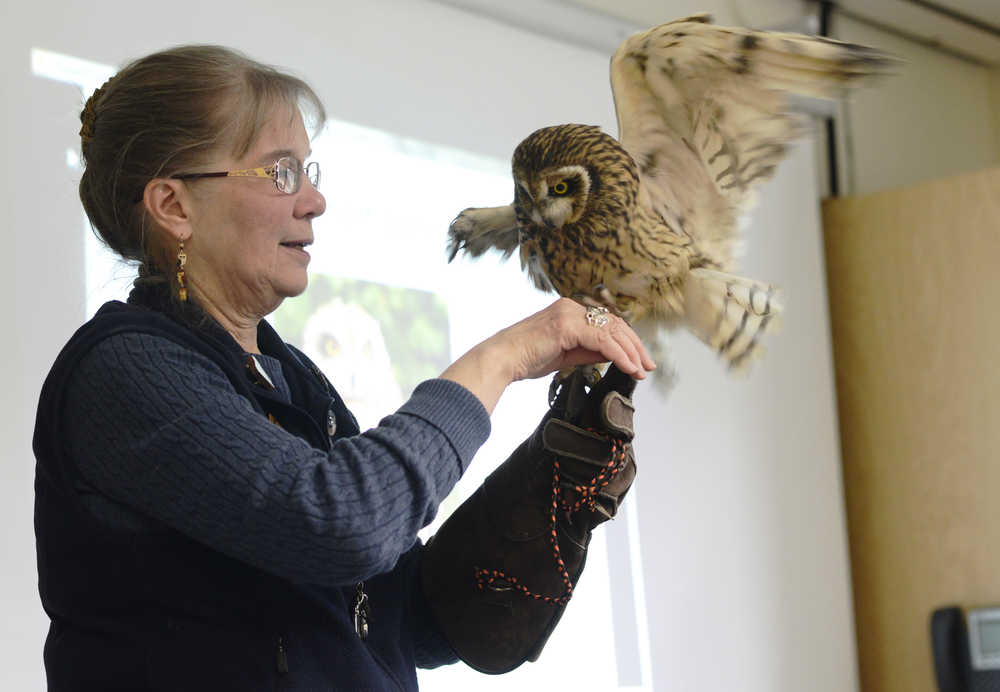Last summer at a day camp in Chugiak, a group of Girl Scouts discovered a bear skeleton in the woods.
The normal program was thrown out and the day became all about the bear. Girl Scout Program Coordinator Jen Pudge said the scouts had questions about “pretty much anything you can think of.”
“They wanted to know if it was a male or a female — you can tell from the bones,” Pudge said. “They wanted to know how it died. They wanted to know if there were more bears in the area — they were a little freaked out about it.”
Turning that natural curiosity into a habit of systematic inquiry was the goal of the Girl Scouts’ Women of Science event, held Saturday at Kenai Peninsula College, in which local girl scouts participated in talks and demonstrations with women including marine biologist Diana Stanley, Bartlett High School physiology teacher Kelly FitzGerald, volunteer bird rescuer Sharon Larson of Anchorage’s Bird Treatment and Learning Center and Kenai Wildlife Refuge Park Ranger Leah Eskelin.
“This kind of event is defining, ‘Look, you may not know it yet, but you already are a scientist in those observation skills, those curiosities, and knowing and paying attention to the world around you,’” Eskelin said. “That’s science.”
Eskelin’s session also provoked questions about bones. Introducing a group of around 10 girls to an animal skull fragment found on the refuge, she led them through an investigation into the skull’s teeth, teaching them different types of teeth, then comparing the unknown animal’s mix of tooth-types to known skulls to infer its eating habits and ultimately its identity.
Eskelin said the process of making observations about the skull, comparing them to known facts and eliminating possible theories was a general science skill she hoped girls would take from her session.
“My take-home lesson for them is that scientists don’t know everything,” Eskelin said. “Scientists know how to research, how to observe, how to be curious. Then by developing those skills, you can figure mysteries out.”
FitzGerald said her presentation about the heart — in which she passed around a sheep’s heart in a sealed plastic bag, taught students to measure their pulses and calculated the group’s average heart rate before and after a vigorous run outside — was meant to combine the abstract with hands-on activities.
“It’s STEM (Science, Technology, Engineering and Math), so combining math and science and hands-on activities is good,” FitzGerald said. “I mean, we go outside, I like to have kids learn through hearing and moving and touching and seeing, and sharing their own experiences.”
FitzGerald said she sees a gender split in her work between different areas of the medical field.
“In the medical classes that I teach at Bartlett, and in the nursing field especially, it’s biased toward women,” FitzGerald said. “There’s more women in that career field. When it starts to get toward things like paramedic, fire-fighting, doctor or anesthesiologist, then it’s much more skewed toward males… I think that in the past, the more care-giving professions people have thought of as careers for women, while the ones that have more science and math and more schooling involved, have traditionally been more male careers. But that’s evening out really fast. And I think events such as this are really helping to get kids interested young and really hone their skills and math.”
FitzGerald said she believes the gender slant will fade “the more exposure kids get, and more we talk about different career fields — not just doctors and nurses, but there’s radiologists and pulmonary therapists and physical therapists and all of the different careers.”
“That’s one of the things I really like to help kids understand — that there’s more in the medical careers than just doctor or nurse,” FitzGerald said. “It’s so big.”
Other presenters also noted a divide in the types of science careers in which women are well represented. Eskelin said the researchers at the refuge are evenly balanced between men and women, and she believes the Alaska Department of Fish and Game has a similar balance among its scientists.
Pudge, an organizer of Saturday’s events, added that other STEM careers remain less even.
“When I was looking for women to present here, it’s usually pretty easy to find biologists,” she said. “When you get to engineering, it’s very heavily male-led. I found one female engineer in this area.”
Like FitzGerald, Eskelin said the split has to do with differing exposures to science and engineering that boys and girls receive while they are young.
“Here’s a sandbox, here’s some construction equipment — go figure out how engineering works,” Eskelin said. “If you try to define what child is being told to do that, it’s generally a little boy. There’s gender biases that are there. To some degree, it’s OK to encourage the little boy to go and play in the sandbox, but the little girl should also be playing in the sandbox.”
She said that while girls and boys often have similar play experiences, girls are less often told about what skills they are learning in play.
“If you don’t have childhood experiences with engineering, defined as engineering, you don’t know and it’s not your fault,” Eskellin said. “That LEGO set that fascinated you for years, you didn’t realize that was actually the potential building blocks — literally — that go into an engineering career, because it’s not defined. But it’s exposure to events like this that give kids the idea that there’s potential here.”
Reach Ben Boettger at ben.boettger@peninsulaclarion.com.

